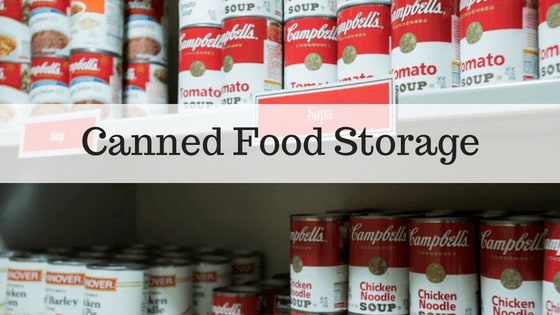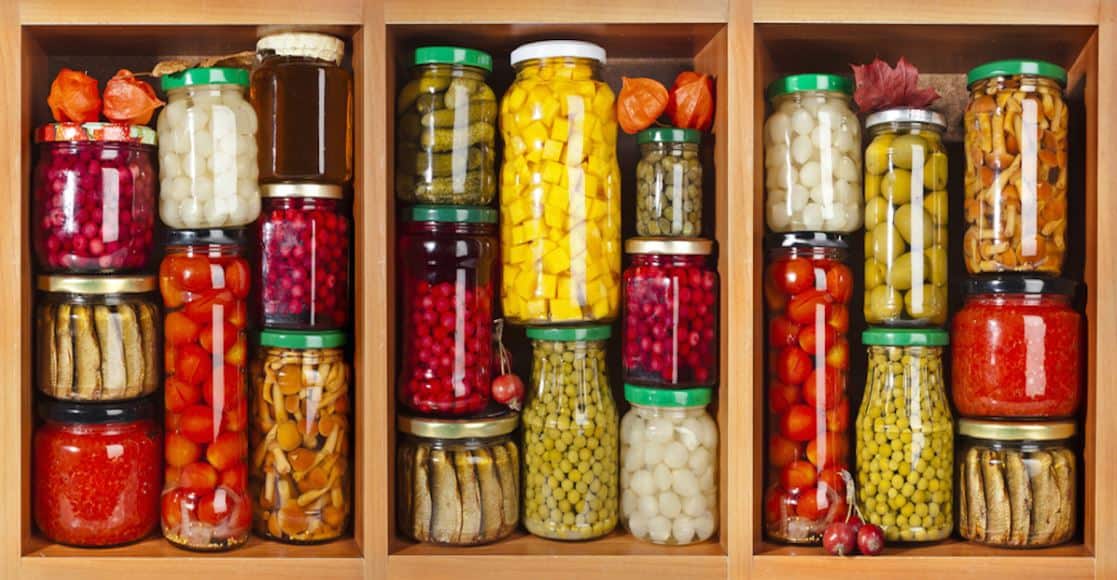Most people don’t think much about canned food storage. And no, it is not just putting cans in your cabinets after each shopping trip. There is a lot more to it and I am going to break down how to store canned food for the long term.
The best way to maximize the time you can store your canned goods is by placing it in a cool, dry place with a temperature of between 50 and 70 degrees.
You should also make sure you rotate cans by the expiration date.

Also, canned food, which is usually stored in liquid, lasts a lot longer than fresh produce, fish, or meat. However, fruits, vegetables, ham, tuna, and sardines can be stored in cans. Food stored in cans may lose some of its nutrients during the canning process, but they still offer a healthy, cost-effective alternative to fresh and frozen foods.
Most canned foods are sold commercially in grocery stores, although some people can get food at home. Home-canned foods are stored in jars instead of cans, but the process is still referred to as home canning.
The most common foods for home canning are relish, preserves, fruits, vegetables, and spaghetti sauce. High acid foods, like fruits and pickled vegetables, are more popular with home canners because they won’t produce Clostridium botulinum toxin due to their low pH balance.
The Basics of Storing Canned Food
You may need to learn more about canned food storage for regular home use, or you might be interested in storing extra food in case of an earthquake or other natural disasters. The following tips will help you to store canned food safely, save money, and ensure you have plenty of quick, healthy meals available for your family.
Also, keep in mind that sunlight can reduce the quality of canned food and even affect its flavor. Your canned food storage space should be in a dark area, far from windows. A pantry, separate storage room, root cellar, or dry basement are your best bets to keep canned food better-tasting longer.
Expiration Dates
The dates below indicate when to eat canned food for the best taste.
- Use canned seafood (tuna, sardines, etc.) within a year of purchase or canning.
- Low-acid canned foods (beans, peas, etc.) should be consumed within eight to 12 months.
- Eat high acid foods (pickled vegetables, most fruits) within 12 to 18 months.
- Canned fruit juice lasts for up to three years.
- Also, keep in mind to rotate the cans, so the oldest food is used first.
Never store canned food at temperatures above 85 degrees. Keep food fresher longer by storing jars and commercially canned foods at a temperature between 50 and 70 degrees F. When the temperature is above 70 degrees, food may spoil or lose its flavor.
You may be tempted to store canned food in your garage, but most garages offer climate extremes – they are too damp, too hot, or too cold. Storing soda or beer in an old fridge in the garage is fine, but you should keep canned food in a pantry or climate-friendly storage space in your house.
Humidity
Choose a storage area with humidity of 15 percent or less, if possible. Moisture will harm dry and liquid-packed canned goods and should be kept to a minimum. Use an air conditioner or dehumidifier to keep the indoor climate moisture-free during humid months.
Find packaging that resists moisture, and keep cans away from the bare floor or contact with outside walls to avoid condensation caused by variations in the temperature of the container and the wall or floor.
More Organizing Ideas if You Run Out of Space
If you run out of space in your pantry or kitchen, think about buying (or building) new shelving units to hold cans. You may also use drawers (if they are deep enough) to hold cans. You can write the name of the food in each can on the lid in Magic Marker or use a label.
An over-the-door organizer can be used instead of shelves to hold cans, and large baskets can hold cans if you’re on a budget or just don’t have the room for additional shelves.
How Long Should You Store Canned Food?
Food stored longer than the dates listed above is probably still safe to eat. However, always inspect the food before tasting any of it. Don’t eat any food that looks or smells bad.
Store-bought canned food will last long past the stamped expiration date, although the contents might not taste as good. Use a Lazy Susan for canned food storage and be sure to rotate the cans, keeping the older cans in the front and the newer cans in the back. Remember to use the older cans first, as long as they’re still in date, of course.
Commercial food cans may corrode, especially if they contain tomatoes or other highly acidic foods. Natural substances in the food react to the tin container over time. After a few years, these interactions change the food’s texture and taste. The chemical interactions degrade the food’s nutrient content.
Canned Food Storage at Home
- Before you store home-canned food, remove the ring bands from tightly sealed jars.
- Then, rinse the jar and lid to get rid of food residue.
- Let the jar dry.
- Excess food residue can cause mold growth on the outer jar during storage.
- Make sure ring bands are clean, dry, and placed far from any potential moisture. For best results, store jars without ring bands for easier identification and for broken vacuum seals.
- Clean and dry ring bands first if you must use them during storage.
- Clearly label and date each jar.
Finally, don’t store more food than your family can eat in a year. This will save space and prevent contents from spoiling. Also, refrain from storing jars in areas that may develop temperatures of 95 degrees or above.

Location Where to Store Your Canned Foods
Damp storage areas will make lids and bands rust, and this will be no good for sealing homemade cans of food. If you don’t have a basement, you can store canned goods on shelves in a dark, dry hallway closet. Keep them away from furnaces, hot pipes, or attics lacking insulation.
Take care not to stack jars too high on top of one another. Jars stacked in more than two layers may cause vacuum seals to come undone. Jars should be stored in boxes, or place a piece of lumber or other hard material between layers of jars.
Food will not spoil if jars freeze accidentally unless the seals loosen. Freezing and thawing food may soften it. Wrap jars in newspapers, and put them in cartons if you think they might freeze. Top the cartons with newspapers and blankets.
How to Tell if Canned Food from the Store is Safe to Eat
You may wonder if commercially canned food is still safe to eat after you’ve stored it for a few years, even if the expiration date is soon to expire. If you’ve stored the cans properly, the food inside should still be safe to eat.
Here are a few precautions you should take before tasting any canned food you store.
Tiny holes are common in severely rusty cans, and bacteria may contaminate the food. So, throw rusted cans away; unless they have slight surface rust, you can rub them off with your finger. Also, avoid purchasing deeply dented, rusted, or bulging cans from the bargain bin at the supermarket.
How to Check Stored Canned Foods for Safety
Food in cans with small dents is safe to eat. However, throw out the deeply dented cans. Sharp dents in the side seams on cans can let bacteria seep into the food.
Commercially canned food that freezes may develop Clostridium botulinum. If a frozen can swell, it may be due to frozen food expanding, but there’s always the chance it is because of Clostridium botulinum or other dangerous organisms. Throw out swollen cans of food.
Throw out cans that have thawed at 40 degrees or above, as any commercially purchased canned food that thaws and is refrozen is potentially dangerous to eat.
Defrosting Frozen Cans of Food
If you find frozen food cans that haven’t been thawed, you can defrost them in your refrigerator. Inspect the food after you’ve defrosted it. Don’t taste it, but check to see if it looks and smells normal. If not, discard it.
If a defrosted can of food looks and smells normal, boil it for 10 to 20 minutes immediately after opening the can. Boil food for 10 minutes if you live at an altitude of 1,000 feet or below, and add an extra minute for each additional 1,000 feet of elevation. Boil high-density corn and spinach for 20 minutes regardless of the altitude.
Refrigerate or freeze defrosted canned food for later use.
Further Tips for Safe Eating the Canned Food
- You may find glass-like crystals in some canned seafood. These crystals are “struvite,” or magnesium ammonium phosphate, which is naturally formed after shellfish or other fish are canned. According to the FDA, these crystals aren’t harmful, and the fish is still safe to eat.
- Some canned foods make a hissing sound when opened because it is vacuum-packed. If the hissing is too loud or food spurts out of the can, don’t taste the food. Put it in a garbage bag and place the bag in a trash bin.
- Temperatures over 100 degrees F are harmful to canned foods. Also, the risk of spoilage jumps sharply as storage temperatures rise. Not to mention that at prolonged storage temperatures above 75 F, nutrient loss in canned foods increases.
- Canned food storage and store-bought canned food is easy as long as you rotate the cans from the oldest to the most recent, keep them in a cool, dry, and dark place, and make sure the lids are air-tight to keep outside oxygen from damaging the contents.
- If the canned food is sealed, don’t place it over (or in) an open flame! When a can is closed, the contents do not have enough room to expand under the heat. So, it can cause a minor explosion (and major mess).
- Commercially canned foods can be safely eaten straight from the can as long as the container is intact. However, DO NOT use home-canned vegetables unless you have the means to boil them for 10 minutes before eating.
Final Thoughts
All in all, now you know every essential detail about canned food storage, so you are ready to prepare your store cupboard for any unfortunate possibility! As I keep telling you on this blog, it is really important to be prepared for any possibility these days. Not to mention the whole pandemic situation that really freaks all of us out! Therefore, learning how to can and store some extra supplies can become super handy somewhere in the future.
Finally, it’s time for you to share with me and our beautiful community all your thoughts about this article and the tips I gave. You know how important is your feedback to me, so please, do not hesitate to be honest. Also, please ask any other further questions in the comment section, as I will be waiting for them. Thanks a lot for reading and stay safe!
Becky is a wildlife enthusiast and pet and livestock care expert with a diploma in canine nutrition. With over a decade of experience in animal welfare, Becky lends her expertise to Simple Family Preparedness through insightful info about pets, livestock, bee keeping, and the practicalities of homesteading.


This article has a lot of very important information. Very well done